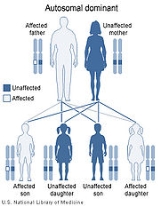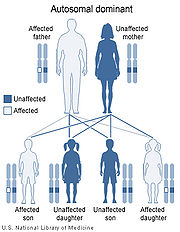
Dermatopathia pigmentosa reticularis
Encyclopedia
Dermatopathia pigmentosa reticularis (also known as "Dermatopathia pigmentosa reticularis hyperkeratotica et mutilans," "Dermatopathia pigmentosa reticularis hypohidotica et atrophica," and "Dermatopathic pigmentosa reticularis") is a rare, autosomal dominant congenital disorder
that is a form of ectodermal dysplasia
. Dermatopathia pigmentosa reticularis is composed of the triad of generalized reticulate hyperpigmentation, noncicatricial alopecia
, and onychodystrophy.
protein.

Congenital disorder
A congenital disorder, or congenital disease, is a condition existing at birth and often before birth, or that develops during the first month of life , regardless of causation...
that is a form of ectodermal dysplasia
Ectodermal dysplasia
Ectodermal dysplasia is not a single disorder, but a group of syndromes all deriving from abnormalities of the ectodermal structures. More than 150 different syndromes have been identified. Despite some of the syndromes having different genetic causes the symptoms are sometimes very similar...
. Dermatopathia pigmentosa reticularis is composed of the triad of generalized reticulate hyperpigmentation, noncicatricial alopecia
Noncicatricial alopecia
-Causes:Causes of noncicatricial alopecia include:*Alopecia areata*Anagen effluvium*Androgenetic alopecia*Dermatopathia pigmentosa reticularis*Telogen effluvium*Trichotillomania...
, and onychodystrophy.
Presentation
Symptoms include lack of sweat glands, thin hair, brittle nails, mottled skin, and lack of fingerprints.Cause
DPR is comparable to Naegeli syndrome, both of which are caused by a specific defect in the keratin 14Keratin 14
Keratin, type I cytoskeletal 14 also known as cytokeratin-14 or keratin-14 is a protein that in humans is encoded by the KRT14 gene....
protein.


